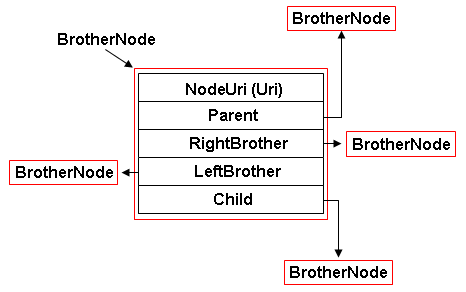During my development of a web site mapper, I decided to save the
information I recovered from each page in a BrotherTree. The
BrotherTree is composed of BrotherNodes, initially
defined as:
public class BrotherNode
{
private Uri node_uri = null;
private BrotherNode parent = null;
private BrotherNode right_brother = null;
private BrotherNode left_brother = null;
private BrotherNode child = null;
Pictorially:

The BrotherNode is actually declared with additional fields,
however, they are not germane to this article.
As each web page is encountered, its hyperlinks were collected
using HtmlAgilityPack methods. The first hyperlink is stored in
the current page's child BrotherNode. All additional hyperlinks
are stored as the child's right-brothers. Adding a node to the
BrotherTree was accomplished by the add_node method:
public void add_node ( BrotherNode parent,
BrotherNode new_node )
{
if ( Root == null )
{
Root = new_node;
}
else
{
new_node.parent = parent;
if ( parent.child == null )
{
parent.child = new_node;
}
else
{
BrotherNode node = parent.child;
BrotherNode next_node = node.right_brother;
while ( next_node != null )
{
node = next_node;
next_node = next_node.right_brother;
}
node.right_brother = new_node;
new_node.left_brother = node;
new_node.child = null;
}
}
}
When all of the hyperlinks, from all of the web pages, had been
collected, I had a BrotherTree that represented the web site.
Accessing the nodes in the BrotherTree is quite simple.
void traverse_tree ( BrotherNode node )
{
if ( node != null )
{
traverse_tree ( node.child );
traverse_tree ( node.right_brother );
}
}
Although traversing a BrotherTree is quite simple, traversing a
BrotherTree and building a TreeView from it proved to be somewhat
problematic. In creating a TreeView, the parent of each new
TreeNode must be used to insert the new TreeNode. I tried a number
of different solutions, all of which were convoluted or complex.
In an A-ha moment, the solution presented itself. Add a TreeNode
to the BrotherNode, resulting in a revised BrotherNode that
looks like:
public class BrotherNode
{
private Uri node_uri = null;
private BrotherNode parent = null;
private BrotherNode right_brother = null;
private BrotherNode left_brother = null;
private BrotherNode child = null;
TreeNode tree_node;
Pictorially:

Now, when building the TreeView (tree_view_TV), we use the
TreeNode in the BrotherNode to record the parent BrotherNode's
place in the TreeView.
void create_tree_view ( BrotherNode node )
{
if ( node != null )
{
TreeNode tree_node = new TreeNode ( node.NodeUri.
AbsoluteUri );
node.Tree_Node = tree_node;
if ( node.parent == null )
{
tree_view_TV.Nodes.Add ( node.Tree_Node );
}
else
{
node.parent.Tree_Node.Nodes.Add ( node.Tree_Node );
}
create_tree_view ( node.child );
create_tree_view ( node.right_brother );
}
}
Adding a field to the BrotherNode reduced an otherwise complex
TreeView creation to one that is relatively simple.
This solution once again supports the thesis that an increase in
space complexity may significantly reduce time complexity.
